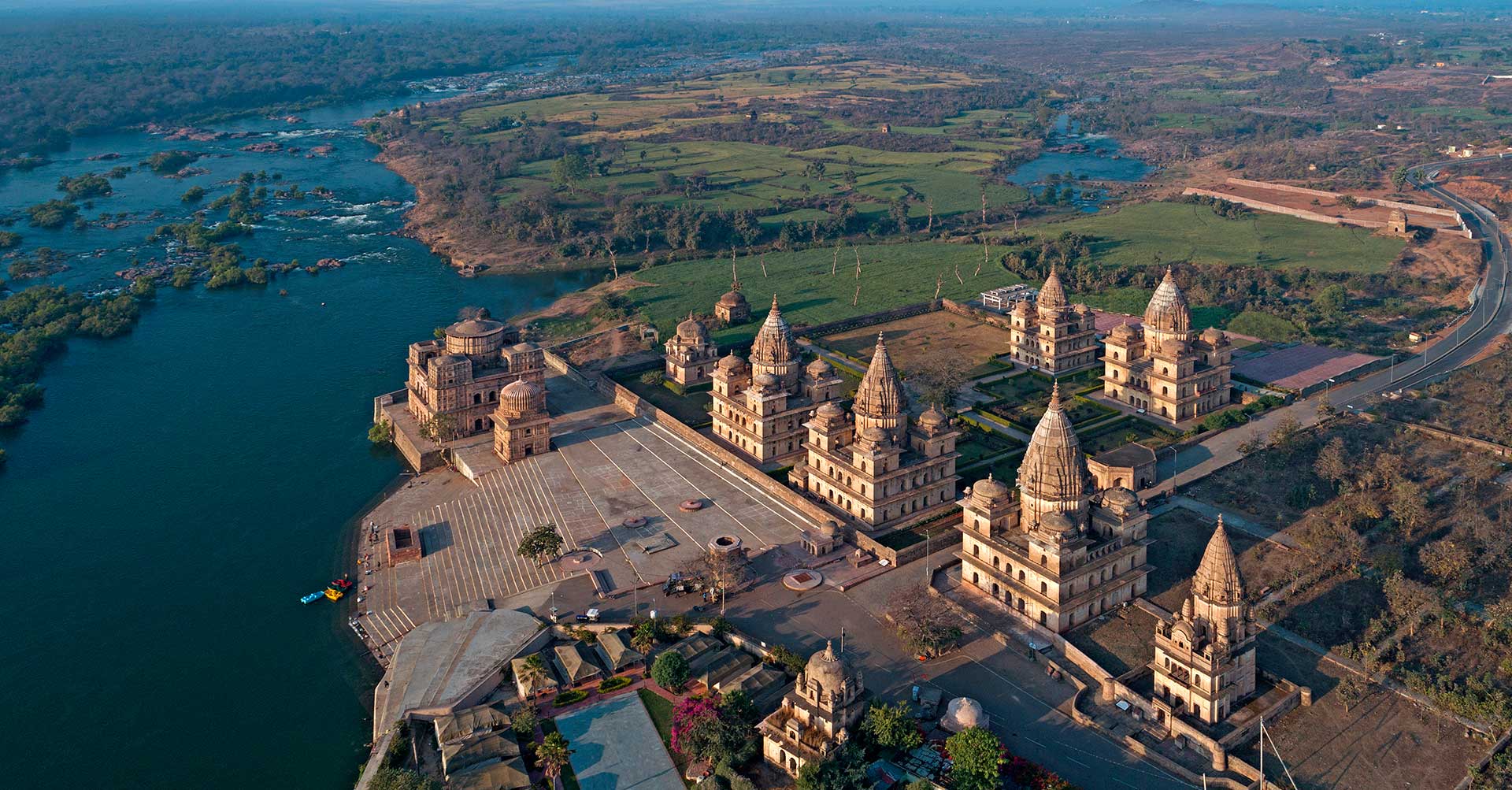Destination Orchha
A marvelous historic town
Orchha is a marvelous town of Madhya Pradesh, which literally meaning `Hidden`. It is an ancient medieval town which was founded in 16th century by the Bundela Rajput chieftain, Rudra Pratap. This stretch of land along the River Betwa in Bundelkhand India was an ideal site for the king`s capital. Marked by the unexampled temples, huge cenotaphs (chhatri), and striking forts, the capital of Bundela Kingdom has beautifully preserved the spirit of its illustrious past and breathes history in every detail. Those who are not fascinated by history, the medieval city doesn't disappoint them either. Encompassed by thick Dhak forest where every dawn is embraced by chirping of birds, where the shimmering holy river and the sighting of rare Indian Vultures atop the rooftops of magnanimous palaces and cenotaphs of Orchha add to the picturesque ambience, the destination appears like a sweet reverie. 20 km away from Jhansi and 175 km from Khajuraho, Orchha is also an ideal weekend getaway from Delhi, Kanpur and Bhopal.
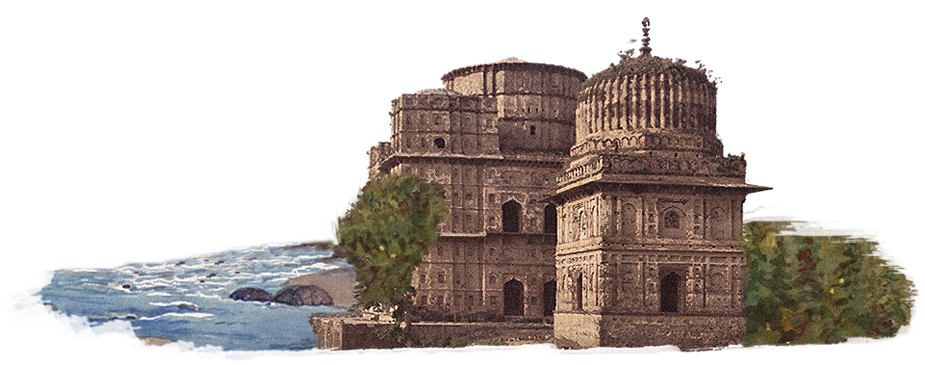
Places of Attraction
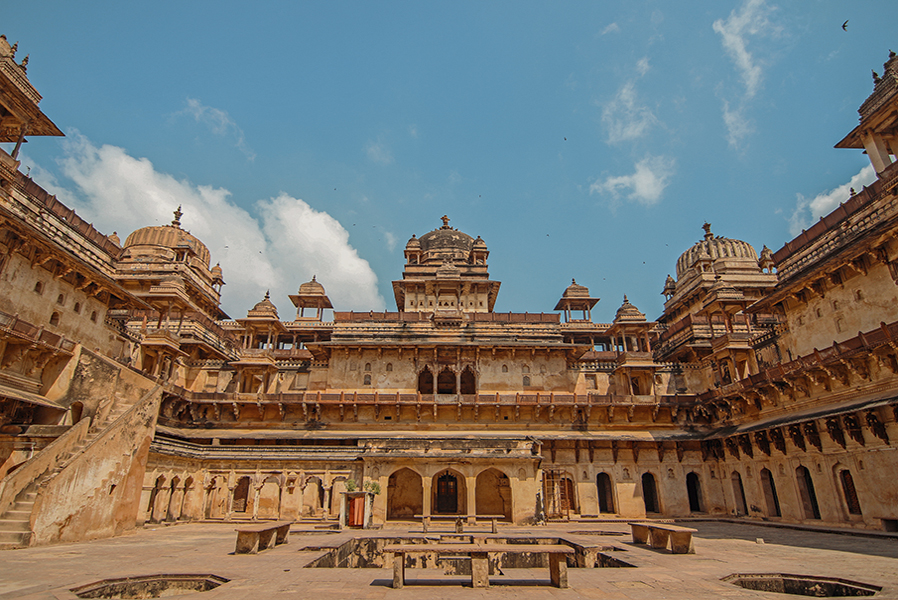
Jahangir Mahal
Jahangir Mahal in Orchha is a delightful example of Bundela architecture and at the same time is an ancient testimony of the bond of friendship between the Mughals and Bundelas. Jahangir Mahal, The most admired palace in Orchha, was constructed by Bir Singh Deo to commemorate the visit of Mughal Emperor Jahanghir to Orchha in 1606. The interiors of the palace are beautifully adorned with paintings of peacocks, flowers and eye-catching geometric patterns. Entered through an elaborate ceremonial gateway, the east-facing portico is coated with turquoise tiles. Two stone elephants flank the stairway, holding bells in their trunks to announce the arrival of the raja by the ringing of bells. The most attractive monument of the Bundela reign, Jahanghir Mahal every year allures the visitors to come back again.

Raj Mahal
The first building you come to across Orchha's medieval granite bridge is the well-preserved ruin of the royal palace, or Raj Mahal (unrestricted access), started by Rudra Pratap and completed by one of his successors, the indomitable Madhukar Shah. Opulent royal quarters, raised balconies and interlocking walkways rise in symmetrical tiers on all four sides, crowned by domed pavilions and turrets; the apartments projecting into the quadrangle on the ground floor belonged to the most-favored queens. As you wander around, look out for the fragments of mirror inlay and vibrant painting plastered over their walls and ceilings. Some of the friezes are still in remarkable condition, depicting Vishnu's various outlandish incarnations, court and hunting scenes, and lively festivals involving dancers, musicians and jugglers. The resident chowkidar of Raj Mahal is an excellent guide.

Rani Mahal
Located very prettily in the splendid fort complex, the Rani Mahal of Orchha is known well for the astounding architecture it has to boast about. Besides this, the lovely paintings of the mahal are simply mesmerizing too. The mahal also means the queen quarters. It was the royal chamber for the wife of Raja Madhukar Singh. He was greatly dedicated to Lord Rama and thus he decorated the rooms of the queen's chamber with murals that depicted scenes from the great epics like Ramayana. The ceilings as well as walls both have beautiful paintings all over them. Now, these days, this mahal has been converted into a museum. This museum thus exhibit paintings that were made in ninth and twelfth century. Also there are various sculptures that are another claim to fame for the museum. One of the most amazing things about this palace is that one can have a breathtaking view of the Betwa River from inside.

Chaturbhuj Temple
One of the city's greatest attractions is the Chaturbhuj Temple, which is situated right opposite the Raja Mahal. Dedicated to the four-armed deity, Chaturbhuj ji, the temple has plenty of light and space inside, a feature unusual for a Hindu temple. Chaturbhuj Temple is built upon a massive stone platform and can be reached by a steep flight of steps. The temple was specially constructed to enshrine the image of Lord Ram that remained in the Ram Raja Temple. Visit the incredible Chaturbhuj Temple personally and get mesmerized by the terrific legend associated with the temple.

Rai Parveen Mahal
A lush garden, with shrubs and flowerbeds pruned in very many artistic shapes, surrounds the palace. Quite obviously; the art of topiary has been in existence in Orchha for centuries. The Mahal was built in honor of the 'Nightingale of Orchha', Rai Praveen, and the second floor is resplendent with scenes of Nritya Mudra, the poses and postures of Indian dance. Rai Praveen was as well identified for her charming beauty as for her poetry and music. The paramour of Indrajit Singh, in whose court she performed, her fame inevitably spread far and wide and finally reached the Imperial Court of Akbar. The Mughal emperor was smitten by her, and he arrogantly summoned her to his durbar. Indrajit Singh, Rai Parveen's paramour, was too weak-kneed a ruler to defy the Imperial summons. Touched by her loyalty, Akbar decided to restore her to Orchha with both her dignity and that of her kingdom intact. The palace is now a fitting memorial to this lady.
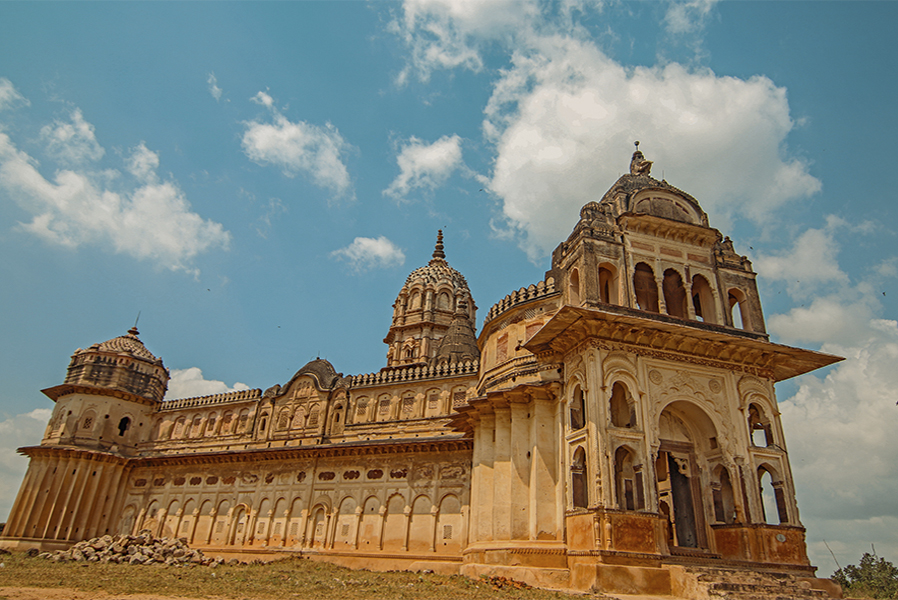
Laxmi Temple
Vir Singh Deo ordered the construction of the Lakshmi Temple around 1622, but due to inadequate maintenance over the years the temple soon began to fall apart and had to be reconstructed by Prithvi Singh in 1793. The temple is worth seeing because it has been built using a mixture of temple and fort architecture. Built for Lakshmi, the Goddess of wealth, inner chambers were built for pilgrims to offer sacrifices to the Goddess. Strangely and unlike the majority of temples, there is no idol of the Goddess kept there. Laxmi Temple in Orchha exhibits a unique style of architecture, which is a beautiful mix of a fort and a temple moulds. The walls of this charming shrine are elaborately decorated with fabulous mural paintings, which show pulsating compositions from mythological themes. This temple also houses the very famous post mutiny paintings. There is a flagstone path that connects Laxmi Temple with Ram Raja Temple, another important structure of this delightful shrine. The temple along with its exquisite paintings presents an enthralling feeling and is a worthy to visit. The fort also houses a Tope Khana (cannon foundry) which kept a vigil around the clock, guarding against any exterior threat from the enemies of Orchha.
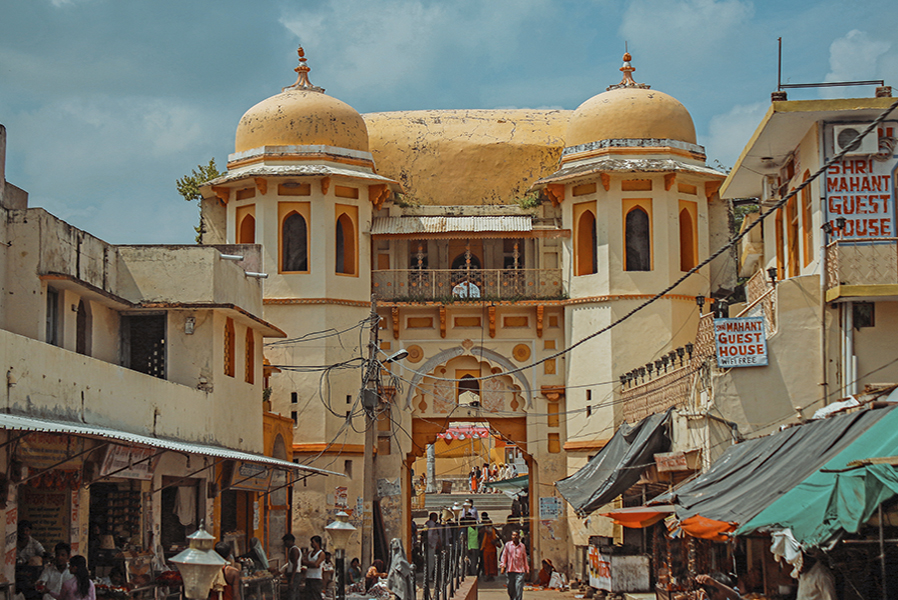
Ram Raja Temple
With its soaring spires and palatial architecture, the Ram Raja temple of Orchha is one of the most unusual temples in India. Though at first glance, the temple built across the road from the Orchha fort complex appears a bit plain, with its simple, yellow and white painted facade but the interior is breathtaking. And, there is a charming legend attached to it which is more enticing. While King Madhukar Shah was a worshiper of Lord Krishna, his queen believed in Rama. Their devotional clash culminated in the king demanding that the queen go to Ayodhya and return with her preferred deity in town. Touched by her plight, Lord Rama in reality appeared to her and agreed to visit Orchha in the form of an infant, but put forth the condition that he would remain in the spot where he was first set down. The king was in hurry to build a grand temple to enshrine the deity, and hence the Chaturbhuj temple, next to the Ram Raja temple was constructed. Today, although Ram Raja Temple remains closed throughout the day, but the heavy silver doors of the sanctum are flung open only at 7 p.m. when the evening aarti is performed. It's a moving ceremony laced with a certain amount of pomp and fanfare. The gun salute reverberates through the night as the lights fade away.

Saket Museum
More of an art gallery than a museum, the Saaket Museum in Orchha showcases some beautiful folk paintings from different states of India. The Madhubani paintings from Bihar are particularly striking. This museum was established by Kapil Tiwari, director of the Adivasi Lok Kala Academy. Keeping in mind Orchha's spiritual and archeological importance, and also its significance as a renowned tourist place, the academy established Ramayan Kala Museum in 2005 at Baroodkhana, Orchha. The museum houses all art items, traditional painting featuring Ramkatha in various styles. Saaket Ramayan Kala Sangrahalaya is the country's first museum which display the traditional arts associated with the Ramayana, themed artwork in various tribal art styles. It also showcases crowns, masks, jewellery and costumes associated with Ramkatha and Ramleela.

Phool Bagh
The Phool Bagh is a laid garden of Orchha and carries the testimony of the highly polished aesthetic sagacity of the Bundelas, who used to rule this small palace. This garden has also served as a summer retreat by the kings of Orchha. This Bagh was built as a memorial for prince of Orchha, Dinman Hardaul. He died as a martyr in order to prove his innocence to his big brother. The structure and premises of Phool Bagh provides a resourceful system for water ventilation and connects the underground palace with Chandan Katora fountain. The place also comprises the Sawan Bhadon Towers, which were built to provide a cooling effect to this 'bagh'. The plantation at this garden is said to have been done in the Mughal style. Dinman Hardaul's Palace is also situated near this garden.
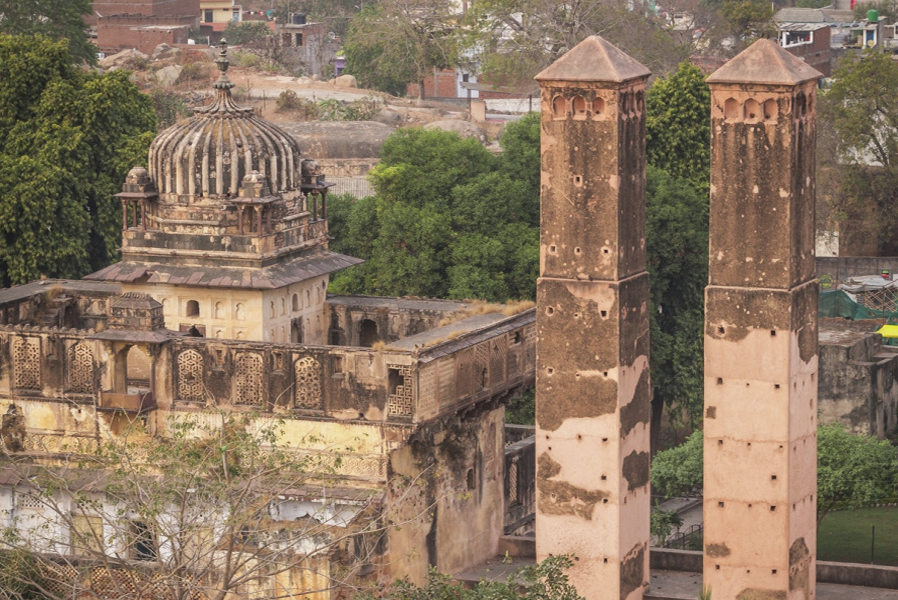
Sawan Bhado Pillars
Adjacent to Ramraja Temple lays a central row of fountains which culminate in an eight pillared pavilion. A subterranean structure below was the cool summer retreat of the Orchha Kings. The Tehkhana was kept cooled by a cleverly constructed Persian cooling unit. This unit was made up of two towers or Dastagirs (two adjoining wind-catching towers) called the Sawan Bhado (names of two spring months in local Indian calendar) pillars built close by. The towers were perforated on the top such that they could catch the wind, while the lower part of the towers was connected to a reservoir of water. The towers, the water distribution system (aqueducts), and the underground reservoir of water were ingeniously connected to a Chandan Katora or fountain in the pavilion above the retreat. The water from the underground reservoir was pushed up into the Chandan Katora and fell like a fountain onto the roof of the retreat thus keeping the Thakhana very cool. They are perhaps the only example of the Persian system of cooling in India. And somewhere it's a tremendous feel good factor after seeing this architectural marvel that the small town Orchha is endowed with such rich heritage and culture.
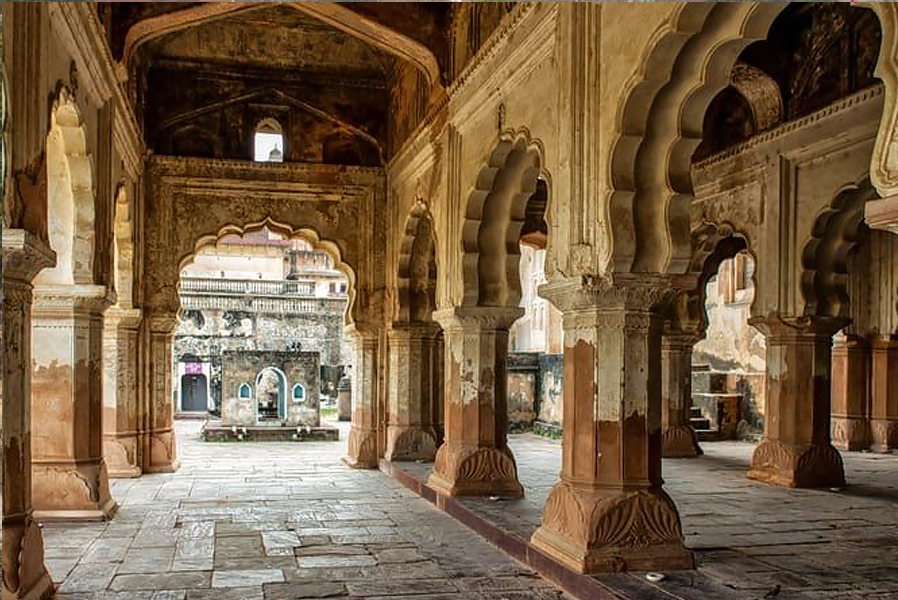
Dinman Hardaul's Palace
Dinman Hardaul's Palace of Orchha in Madhya Pradesh speaks volumes about the respect and love between brothers. An architectural marvel of the ancient times, the Dinman Hardaul's Palace bears relics to the rich religious history and cultural ancestry of the place during the ancient times. According to a historical legend, Dinman Hardaul's Palace was constructed in honor of the great religious leader, Hardaul who sacrificed his life for his elder brother. The elder brother of Dinman Hardaul, Jhujhar had suspected that his younger brother was romantically involved with his long time companion and friend. Dinman Hardaul who was a highly religious person decided end his life to show his virtuous nature to Jhujhar.
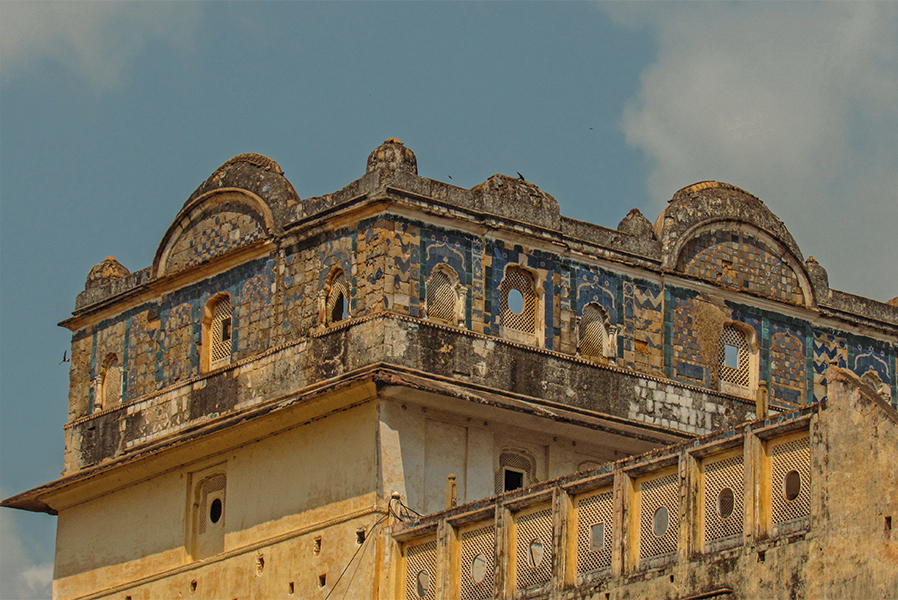
Sheesh Mahal
Built during the early 18th century, the Sheesh Mahal ("Palace of Mirrors") was originally intended as an exclusive country retreat for the local Raja- Udait Singh. Following India's independence the property was inherited by the state government. The low, rather squat palace stands between the Raj Mahal and the Jehangir Mahal, at the far end of an open-sided courtyard. Covered in whitewash and stripped of most of its Persian rugs and antiques, the building retains little of its former splendor, though it does offer stunning views from its upper terraces and turrets.

Sunder Mahal
The Sunder Mahal is another popular palace and an architectural marvel of Orchha. This palace depicts the relics of rich religious fervour and ancient grandeur of this city. It is dedicated to the love story of Prince Dhurbhajan who was a Hindu and his Muslim lover. According to a legend, Prince Dhurbhajan, who was the son of Raja Jujhar Singh, fell deeply in love with a Muslim girl. Due to the resistance of his family towards this relationship, he turned towards meditation and deep prayers. After he got married to his lover, as a result of his prayers, he built this Sunder Mahal. His deep love and meditation turned him into a saint in the eyes of Muslim population. Even today, Muslims come to this palace to seek blessings from the revered soul of Prince Dhurbhajan, to get eternal happiness in their love life.

